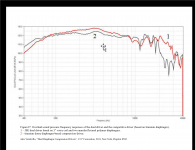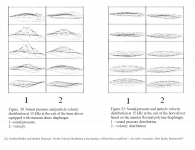Earl,To minimize HOMs and diffraction, the throat aperture must be driven uniformly. This is difficult to impossible to do when there are two diaphragms operating over different frequency ranges (the only real reason that one would do that.) In every dual diaphragm driver that I have measured there is a distinct and significant polar response degradation at the crossover between these two diaphragms.
There is simply no comparison between a dual diaphragm driver and a single diaphragm driver as long as the single can provide the required bandwidth as many many can. But to differentiate themselves several manufacturers make large claims (unsupported I might add.)
The JBL 2408H-1 and D-2 drivers use identical dual annular diaphragms covering the same frequency range, evidently distinctly different than the dual diaphragm drivers that you have measured, as there is no crossover employed between the two diaphragms. The BMS dual annular diaphragm drivers do have problems in the crossover region.
The JBL dual annular diaphragm approach allows double the displacement of a single diaphragm without the high frequency breakup associated with a larger single diaphragm of the same Sd. It is probable that the dual annular diaphragm approach would drive a throat aperture just as uniformly, or perhaps even more uniformly since there are lesser path length differences to correct than a typical dome shaped diaphragm of the same Sd.
It does seem like you would have to look at the total surface area of those two opposing diaphragms and the tortuous acoustic path that they would have to follow. How is this superior to a single larger surface area? Do you really have improved high frequency response having to go around 90degree corners like that? Not much different than what happens in a folded horn vs a straight path horn really, I would think there would be other issues caused by the path itself. This is all conjecture on my part just looking at the cross sectional design that I am seeing here. Anyone have any real measured response compared to a high quality 1" compression driver on a plain wave tube or the same waveguide?
It does seem like you would have to look at the total surface area of those two opposing diaphragms and the tortuous acoustic path that they would have to follow. How is this superior to a single larger surface area? Do you really have improved high frequency response having to go around 90degree corners like that? Not much different than what happens in a folded horn vs a straight path horn really, I would think there would be other issues caused by the path itself. This is all conjecture on my part just looking at the cross sectional design that I am seeing here. Anyone have any real measured response compared to a high quality 1" compression driver on a plain wave tube or the same waveguide?
Ring radiators have always had one advantage, and another disadvantage.
They have response which is extended at the top of their bandwdith, because the pathlengths of a ring are equal. For instance, if you have a 1" dome that is perfectly spherical the tip of the dome is 1.27cm ahead of the bottom of the dome. (Just simple geometry.) Due to the difference in pathlength, the tip of the dome is 1/2 wavelength ahead of the base of the dome at 13,385hz, and the problem only gets worse as you go higher in frequency.
The disadvantage of a ring is simple; it has less displacement because a ring has less surface area than a dome of equivalent size.
Alex Voshivillo's solution is elegant and simple : two rings face to face.
Patrick's explanation of the dome shows why in compression drivers the Dome is reversed to become a cup.
Then they add a "contraption" that more or less effectively tries to equalise the path lengths from all parts of the moving cup to the throat.
Then they add a "contraption" that more or less effectively tries to equalise the path lengths from all parts of the moving cup to the throat.
That cross section does leave out the, um, resonance avoidance strategy:This is all conjecture on my part just looking at the cross sectional design that I am seeing here.
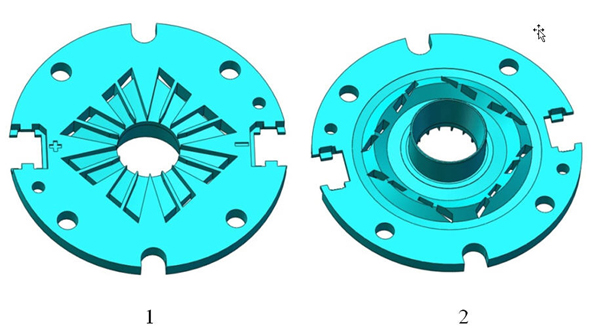
I wish I had a couple of hours to kill. I have the BMS ring radiator, JBL 2408H-1, and B&C DE250 here. It would be fun to pit them head-to-head, particularly since I've hacked up some JBL PT waveguide clones so that they can be used with bolt-on compression drivers. (The 'stock' JBL PT waveguide requires a screw on, like the BMS 4540 and JBL 2408H-1.)
Until I can find that, here's some food for thought:
1) A JBL speaker with the 2408H-1 : http://www.jblpro.com/ProductAttachments/JBL_AM5212_95.SS.v1.pdf
2) And then compare those measurements to the conventional compression drivers.
JBL still uses plenty of 'conventional' compression drivers, but I couldn't find any that included both directivity plots *and* frequency response plots. Most just had directivity plots.
As for that phase plug, I think it's kind of ingenious. It varies the pathlengths by about a centimeter. Should smooth out the response, since many peaks and dips in loudspeakers are simply due to geometry. (Check out the Dayton RS52AN for instance, where it's geometry creates a giant peak in the high frequency response which isn't correlated with a resonance.)
Until I can find that, here's some food for thought:
1) A JBL speaker with the 2408H-1 : http://www.jblpro.com/ProductAttachments/JBL_AM5212_95.SS.v1.pdf
2) And then compare those measurements to the conventional compression drivers.
JBL still uses plenty of 'conventional' compression drivers, but I couldn't find any that included both directivity plots *and* frequency response plots. Most just had directivity plots.
As for that phase plug, I think it's kind of ingenious. It varies the pathlengths by about a centimeter. Should smooth out the response, since many peaks and dips in loudspeakers are simply due to geometry. (Check out the Dayton RS52AN for instance, where it's geometry creates a giant peak in the high frequency response which isn't correlated with a resonance.)
The new JBL unit is quite unique and I have not had a chance to evaluate it. Alex is certainly a knowledgeable engineer and he may have found something useful. It is a slick design, admirable. For me, until I see definitive data to support that this technique does work better, the jury is still out as to its being any "better".
When I first saw this design I saw it more as a complexity and cost reduction technique and not as some grandeur performance improvement. As I have said, I don't see compression drivers in need of improvement (for what I do, i.e. home systems.)
If someone wants to send me one of these drivers I will test it and post the results for all to see. Until then it is all hypothetical conjecture to me.
PS. Lets not forget that the use of a single annular disk is old and I think there are some patents on it and how the phase plug is done. This means that the entire rational for the dual diaphragm design may just be to avoid the patents.
I was recently hired to find a "work around" for some patents in this same area. It is quite a common way of doing designs. Often the "work around" is not as good, but it doesn't violate any patents so into production it goes. Then marketing makes these design changes (flaws) into an "asset" and away we go ...
When I first saw this design I saw it more as a complexity and cost reduction technique and not as some grandeur performance improvement. As I have said, I don't see compression drivers in need of improvement (for what I do, i.e. home systems.)
If someone wants to send me one of these drivers I will test it and post the results for all to see. Until then it is all hypothetical conjecture to me.
PS. Lets not forget that the use of a single annular disk is old and I think there are some patents on it and how the phase plug is done. This means that the entire rational for the dual diaphragm design may just be to avoid the patents.
I was recently hired to find a "work around" for some patents in this same area. It is quite a common way of doing designs. Often the "work around" is not as good, but it doesn't violate any patents so into production it goes. Then marketing makes these design changes (flaws) into an "asset" and away we go ...
Last edited:
Patrick,
It would be nice to see some real world numbers and not just what JBL publishes. I guess if you only want to look at a compression driver as a plain wave your assumption of path length would hold true, but not convinced that path length can't be corrected with proper engineering, not to say that wouldn't introduce other problems or that it is a simple problem to overcome.
Dumptruck,
Thanks for the added drawings. It looks like they are using a distributed path length which is just what Patrick was talking about being a bad idea in a normal compression driver so go figure! Theory and reality sometimes don't match up. I would say the Tannoy Tulip design is one way that this problem was approached to advantage. Some solutions just add to much to the manufacturing cost of a device and that is why you don't see some of those solutions.
It would be nice to see some real world numbers and not just what JBL publishes. I guess if you only want to look at a compression driver as a plain wave your assumption of path length would hold true, but not convinced that path length can't be corrected with proper engineering, not to say that wouldn't introduce other problems or that it is a simple problem to overcome.
Dumptruck,
Thanks for the added drawings. It looks like they are using a distributed path length which is just what Patrick was talking about being a bad idea in a normal compression driver so go figure! Theory and reality sometimes don't match up. I would say the Tannoy Tulip design is one way that this problem was approached to advantage. Some solutions just add to much to the manufacturing cost of a device and that is why you don't see some of those solutions.
Earl,
The JBL 2408H-1 and D-2 drivers use identical dual annular diaphragms covering the same frequency range,
Yes, I knew this, which is why I was hedging what I said to "most" dual diaphragm drivers. I don't see - for home use - where more Sd or excursion is required. In that application a compression driver has power to throw away, and one usually does, to match the much lower woofers levels.
Patrick,
It would be nice to see some real world numbers and not just what JBL publishes. I guess if you only want to look at a compression driver as a plain wave your assumption of path length would hold true, but not convinced that path length can't be corrected with proper engineering, not to say that wouldn't introduce other problems or that it is a simple problem to overcome.
Dumptruck,
Thanks for the added drawings. It looks like they are using a distributed path length which is just what Patrick was talking about being a bad idea in a normal compression driver so go figure! Theory and reality sometimes don't match up. I would say the Tannoy Tulip design is one way that this problem was approached to advantage. Some solutions just add to much to the manufacturing cost of a device and that is why you don't see some of those solutions.
Some thoughts:

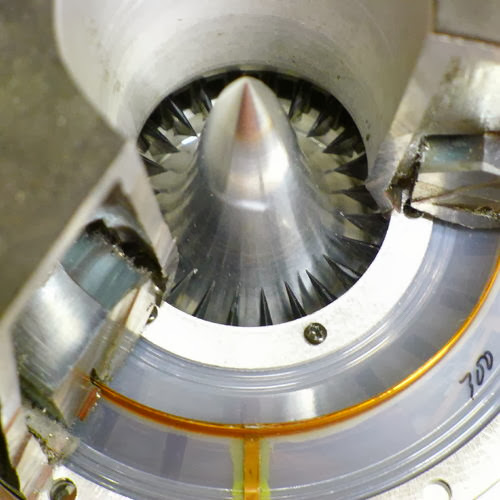
1) With a BMS ring radiator, the pathlengths are equidistant from all points on the ring if you're listening on-axis. You can see this if you take one apart; the phase plug is incredibly simply, it's basically a bullet. Whether that's a defect or a feature really depends on how you look at it. If there's a peak or dip caused by geometry, the equal pathlengths will exacerbate it.

2) The phase plug of the D2430K and 2408H-1 will randomize the path lengths a little bit. I'm assuming JBL considers this an improvement, as the 2408H-1 is clearly based on the BMS 4540ND. (This would probably be the easiest measurement for me to do, as both the BMS and the JBL work on the same waveguide.)
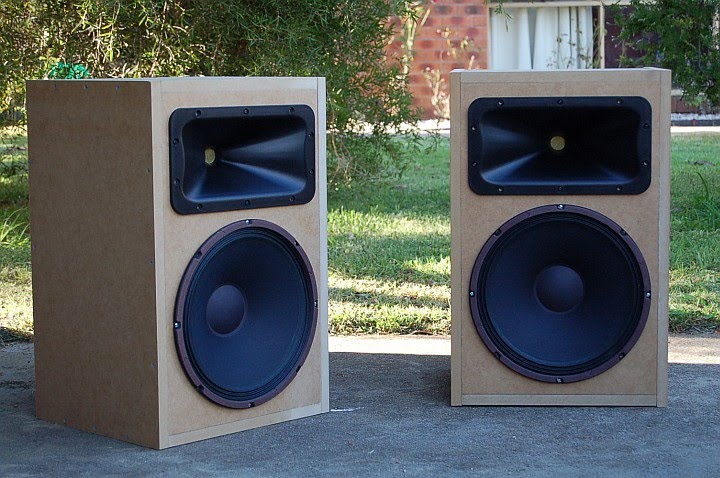
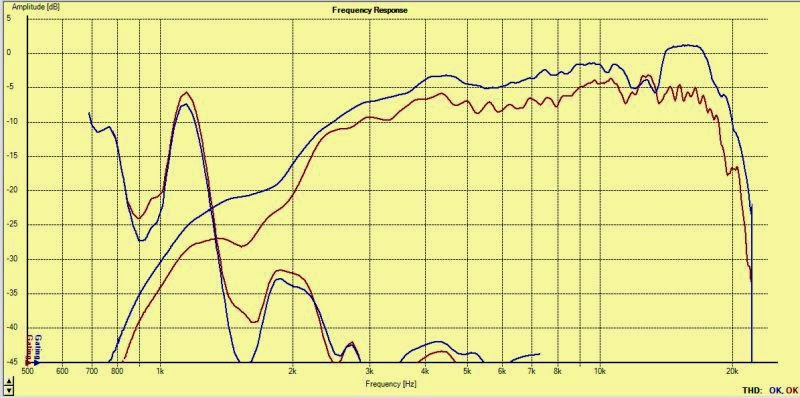
Here's the on and off-axis response (45 degrees) of a JBL 2408H-1 on a clone fo the JBL PT waveguide
An externally hosted image should be here but it was not working when we last tested it.
Here's some measurements of a 4540ND from AudioKarma.
It's on a different horn, so I'd really like to pit mine head-to-head. To me, the 2408H-1 looks smoother on-axis and off. Is this the work of a superior phase plug? Maybe. When I see peaks and dips that are harmonic, like the broad hump at 4khz and the dip at 8khz, I generally suspect geometry.
When I first saw this design I saw it more as a complexity and cost reduction technique and not as some grandeur performance improvement. As I have said, I don't see compression drivers in need of improvement (for what I do, i.e. home systems.)
In this I have no doubt. I own the 4540s and waited patiently for the 2408H-1 (which seems to be an evolution of the former.)
First thing I noticed : wow, these are much, much heavier. For a driver that fits in your hand, the 2408H-1 has a LOT of neodymium in the motor. It is *significantly* larger and heavier than it's competitors in the class, like the 4540ND and the Celestion CDX1-1425 and the small B&C neo drivers.
I was excited to find out if it was smoother, but to my ears, there was no noticeable improvement over it's competition. (I think it might measure a little bit better, but is it audible? Not that I can tell.)
But the really noticeable thing was that this is probably the loudest compression driver I've ever tested. I had to ramp down my output levels by about 6dB just to keep from clipping the mic. The thing is crazy loud.
I have some 6.5" woofers with neodymium motors, and the motor on the 2408H-1 is about the same size. It's a monster.
The 2408H-1 is made in Mexico, the 4540ND in Germany.
Patrick,
An easy marketing trick would be to use a lesser grade of Neo magnet material and use more of it to make a product seem like it has a better motor assembly. I am not saying that JBL is doing that, just that people seem to lump all neo in the same category when there are such a wide range of magnetic properties in various grades. I would never consider the magnetic mass as the important factor with that material.
An easy marketing trick would be to use a lesser grade of Neo magnet material and use more of it to make a product seem like it has a better motor assembly. I am not saying that JBL is doing that, just that people seem to lump all neo in the same category when there are such a wide range of magnetic properties in various grades. I would never consider the magnetic mass as the important factor with that material.
What Transistion?
I would argue that the performance of some are acoustically the same and some are not, and that the interest here, is focused on the latter of these two groups. Besides the measurements, my ears tell me that acoustical differences exist between different horns and compression drivers as well, and that these differences are audible and important. Here the mediocre performance of the majority is not at issue.
Furthermore, from the point of view of a user, a "commodity" is any purchased item not subject to the user's design control; otherwise it is considered an in-house designed component, sub-assembly or product.
So this attribution does not make any sense as an acoustical argument.
Also note should be taken that most readers here do not have access to a well-equipped acoustics lab, so the hypotheticals will continue. As this is the starting point of all innovation, what is wrong with it appearing here?
There is no transition in the operation of the ring diaphragms in Voishvillo's design [1] (JBL D2 Dual Diaphragm Compression Driver), they both operate in opposition to each other over the same frequency band. The design is meritorious as demonstrated in part by the PWT frequency response graphs [2], and particularly the shapes of wave fronts exiting the driver as compared in charts [3]. These were generated using the method presented in paper [4].
It is apparent that some performance potential has been traded for the value engineering introduced into JBL’s D2 production models.
Keeping the compression chamber and phase plug passages air-tight, looks to be a potential problem, due to the multiplicity of componentry required to enclose them.
Regards,
WHG
[1] Title: Dual Diaphragm Compression Drivers
AES E-Library Dual Diaphragm Compression Drivers
[2] Figure 17 (JBL-D2-PWT-FR.png)
[3] Figures 20 & 21 (JBL-D2-WFP.png)
[4] Title: On the Velocity Distribution at the Interface of Horn Driver and Horn
AES E-Library On the Velocity Distribution at the Interface of Horn Driver and Horn
The same argument can be applied equally as well to a horn/waveguide component of a driver/baffle system.I have failed to see any "waveguide" discussion in the last few pages, only a bunch of hypotheses about how to make the "best" compression drivers. Having used and measured a lot of them my conclusion is that they are all about the same, basically they are a commodity.
I would argue that the performance of some are acoustically the same and some are not, and that the interest here, is focused on the latter of these two groups. Besides the measurements, my ears tell me that acoustical differences exist between different horns and compression drivers as well, and that these differences are audible and important. Here the mediocre performance of the majority is not at issue.
Furthermore, from the point of view of a user, a "commodity" is any purchased item not subject to the user's design control; otherwise it is considered an in-house designed component, sub-assembly or product.
So this attribution does not make any sense as an acoustical argument.
Also note should be taken that most readers here do not have access to a well-equipped acoustics lab, so the hypotheticals will continue. As this is the starting point of all innovation, what is wrong with it appearing here?
Except that I have yet to see a dual diaphragm unit that I would consider using. There simply is no way to get two diaphragms into a single device that will have a flawless transition between them. And this flaw always occurs in the worst possible frequency range.
There is no transition in the operation of the ring diaphragms in Voishvillo's design [1] (JBL D2 Dual Diaphragm Compression Driver), they both operate in opposition to each other over the same frequency band. The design is meritorious as demonstrated in part by the PWT frequency response graphs [2], and particularly the shapes of wave fronts exiting the driver as compared in charts [3]. These were generated using the method presented in paper [4].
It is apparent that some performance potential has been traded for the value engineering introduced into JBL’s D2 production models.
Keeping the compression chamber and phase plug passages air-tight, looks to be a potential problem, due to the multiplicity of componentry required to enclose them.
Regards,
WHG
[1] Title: Dual Diaphragm Compression Drivers
AES E-Library Dual Diaphragm Compression Drivers
[2] Figure 17 (JBL-D2-PWT-FR.png)
[3] Figures 20 & 21 (JBL-D2-WFP.png)
[4] Title: On the Velocity Distribution at the Interface of Horn Driver and Horn
AES E-Library On the Velocity Distribution at the Interface of Horn Driver and Horn
Attachments
Last edited:
More
Furthermore, the movement of each ring is controlled by two suspensions instead of just one. This feature should suppress rocking modes that occur at lower frequencies.
Regards,
WHG
Earl,
The JBL 2408H-1 and D-2 drivers use identical dual annular diaphragms covering the same frequency range, evidently distinctly different than the dual diaphragm drivers that you have measured, as there is no crossover employed between the two diaphragms. The BMS dual annular diaphragm drivers do have problems in the crossover region.
The JBL dual annular diaphragm approach allows double the displacement of a single diaphragm without the high frequency breakup associated with a larger single diaphragm of the same Sd. It is probable that the dual annular diaphragm approach would drive a throat aperture just as uniformly, or perhaps even more uniformly since there are lesser path length differences to correct than a typical dome shaped diaphragm of the same Sd.
Furthermore, the movement of each ring is controlled by two suspensions instead of just one. This feature should suppress rocking modes that occur at lower frequencies.
Regards,
WHG
To minimize HOMs and diffraction, the throat aperture must be driven uniformly. This is difficult to impossible to do when there are two diaphragms operating over different frequency ranges (the only real reason that one would do that.) In every dual diaphragm driver that I have measured there is a distinct and significant polar response degradation at the crossover between these two diaphragms. This is to be expected and it appears to always be there. To make matters worse it is always in the critical 1 kHz - 5 KHz region where we are most sensitive to errors of this type.
OK so you are not including the M2 driver in this.
Thank you.
whgeiger,
do you have a copy of that AES preprint you listed? The description written on the AES site sound very different than what is shown in the cross-sectional drawing with two separate phase plugs?
do you have a copy of that AES preprint you listed? The description written on the AES site sound very different than what is shown in the cross-sectional drawing with two separate phase plugs?
whgeiger,
do you have a copy of that AES preprint you listed? The description written on the AES site sound very different than what is shown in the cross-sectional drawing with two separate phase plugs?
K,
All references I provide have been read/studied by me before I post them here.
Send me your e-mail address as a private message here.
Regards,
WHG
my ears tell me that acoustical differences exist between different horns and compression drivers as well
I do nothing by ear and I do not take anyone else's subjective data as relevant. Sorry.
Huh?
Out of context. It is in addition to the measurements. I did not ask for your approval. If you do not use your ears, how do you plan on listening to the music?
WHG
I do nothing by ear and I do not take anyone else's subjective data as relevant. Sorry.
Out of context. It is in addition to the measurements. I did not ask for your approval. If you do not use your ears, how do you plan on listening to the music?
WHG
Well I looked at both those articles and from what I see it confirms what I am thinking. I see no change in medium or change in temperature where any refraction would take place. The second article is talking about reflections and not refraction, reflections would appear to be diffraction effects and not refraction effects. Someone want to show me where I am incorrect here?
Yes Earl,
Those horns never worked as described, at least not very well if at all. I do have personal experience with those horns and know them well. This was one of those things that JBL did that just didn't work as planned. The polar response of these horn lenses was pretty bad. Talking about internal reflections back into the horn this takes the cake.
Hi Kindhornman,
I think the way lenses are working is very simple. If You are looking at them it is easy to see that some part of the sound (front) has to pass LONGER path. As the angle of the lenses plate is about 40 degree (in vertical plane), so the longest sound path is about 40% MORE the central part, so everything behave as some part of the sound "front" would pass LOWER SPEED media (here the speed is equal, but the way length differs), but almost without loss. Owing to the hyperbolic "V" shape of the lenses plates, a kind of acoustic lens can be get.
Regards
ivica
- Home
- Loudspeakers
- Multi-Way
- Geddes on Waveguides
